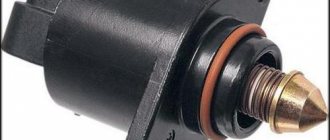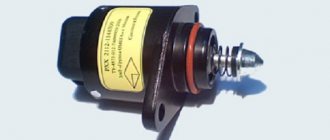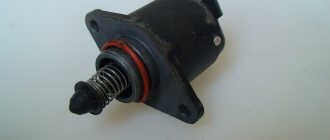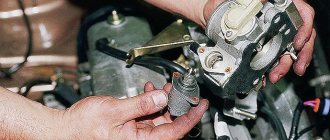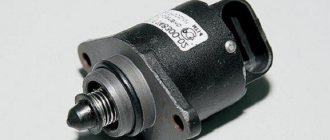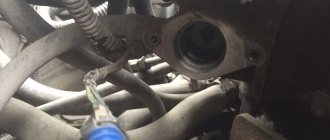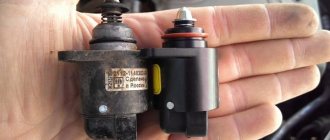Lada Priora was produced by the Volzhsky plant for 11 years, until 2022. The configuration included several classes of engines: a four-cylinder VAZ 21116/11186 with 8 valves and a modernized line of four-cylinder 21126-21128 with 16 valves. The idle speed sensor on the Priora is an integral part of the fuel supply unit for the internal combustion engine, which ensures full operation of the engine at low speeds.
Replacement
Replacement requires only a small screwdriver.
- We turn off the minus sign in the battery, since the work will be done with the electrical equipment of the car.
- Remove the connector from the sensor.
Unscrew the two screws that secure the sensor to the housing and remove the sensor.
- We install the new sensor in the reverse order, not forgetting to install the O-ring.
If after replacement the problem is not solved, you need to clean the throttle valve; how to do this, read below.
Examination
The sensor is checked by applying voltage to it and inspecting the mobility of the shaft. It is best to check by unscrewing the sensor from the throttle body without removing the connector, turn on the ignition on the car and see how the shaft moves. The movement of the shaft “cap” should occur without any biting or twitching.
You should also check the integrity of the sensor housing. Quite often, the metal rivets securing the connector to the sensor body fall out, and air can leak from there. The sensor must be clean and free of traces of contamination; if any, the sensor must be cleaned.
We determine the malfunction ourselves
The regulator is designed to maintain idle speed within a specified range and ensure proper and timely warming up of the engine.
Although engine failures in this mode are rare on the Lada Kalina, practice has made it possible to establish a certain set of signals indicating a malfunction of the regulator.
- When the unit begins to heat up at low outside temperatures, the number of revolutions cannot exceed the threshold value of 1500 per minute, which “delays” the time to reach operating temperature.
- difficulty starting the unit;
- while the gearbox is in neutral, a floating engine speed is observed;
- when the transmission phases change while in motion, the engine spontaneously stops;
Attentive owners of Lada Kalina testify to a decrease in speed after turning on the air conditioning compressor. This often causes the engine to stop and the lubricant pressure symbol on the tiller to illuminate.
The most common malfunction is instability of the speed. When driving above the 50,000 mile mark and such symptoms occur, it is recommended that you first clean the throttle body. Only then will it be possible to replace the controller. This device cannot be repaired, so this action has no alternative.
Replacing the sensor is not difficult and allows you to do it as quickly as possible, the main thing is to know where it is.
Conclusion
Replacing the idle speed control is not a panacea in the fight against floating speed or a throbbing engine. Most automotive electricians have a tester in their arsenal to check the operation of the regulator. To do this, remove yours and give it for inspection. The regulator glitch may be intermittent, but the tester will show the correct picture.
Sometimes I have the same problem, the speed jumps, but the engine does not stall. Now I understand, most likely it is the idle speed sensor. I watched the video, in principle, now I can change it myself.
If the revolutions on 16 valves “float”, then the first thing you should check is the idle speed sensor. The only thing is that not all novice car enthusiasts know where it is and how to change it. It’s good that there are videos with which you can easily figure out what’s what.
A meaningful article that will be useful to every Lada Grant owner who does not want to spend their money on a hundred.
Comments from the same laymen as the author of the article... Do you even understand what you are writing about?
The idle speed sensor in the injection system of the Lada Kalina model is a special electronic device. Such a component can be found in any other car that runs on gasoline and has distributed injection. The design of the sensor is represented by an electric motor, paired with a conical needle by the manufacturer. Note that the device is controlled by an ECU.
The idle speed sensor rarely experiences malfunctions, but if such a fact occurs, it causes a malfunction in the idle speed of the engine. They begin to “float”, and the engine, in turn, ceases to function normally. As a result, achieving a timely return to operating temperature after a cold start becomes problematic.
Route map for eliminating unstable idle speed on a VAZ 2170
Unstable idle is caused by the computer misperceiving or not knowing at all the amount of air being drawn into the intake manifold. A typical treatment recipe looks like this:
- Check the integrity of the brake booster diaphragm.
- Check the sensors (IAC, DFID, TPS) and replace the faulty ones.
- Make sure the canister valve is in good condition.
- If, after cleaning the throttle valve on the VAZ 21126 engine, the speed fluctuates, you need to make sure that there is no air leakage through the fittings to the injectors.
The 16-valve Lada Priora, like other cars with an injector, is equipped with an idle speed sensor designed to maintain constant engine speed at idle. If you notice that your vehicle's idle speed has begun to jump to unacceptable levels, then this is a good reason to check, and in some cases completely replace the idle air control valve.
Symptoms of an IAC malfunction are in many ways similar to the incorrect operation of the traffic police. But in the second case, the Check Engine light indicates a sensor malfunction on the Priora, since signals from the electronic accelerator pedal, fuel regulator, ignition system, etc. They pass through the ECU and are reflected on the dashboard, which is not the case in the case of problems with the idle speed sensor due to the lack of integration into the overall system.
Your own diagnostician: why the engine speed fluctuates on a Priora - a theoretical basis
- failure of the mass air flow sensor (MAF);
- failure of the throttle position sensor (TPS);
- air leak;
- defective idle air controller (IAC).
What the engine will do in this state of affairs is to raise the speed of the power plant, while the volume of injected gasoline will remain the same. This means that the mixture will become leaner and the engine will begin to stall smoothly.
As the crankshaft speed decreases, the amount of air will decrease. After reaching a critical point, at which the injection volume of high-octane liquid is sufficient to obtain a combustible mixture of normal quality, engine operation stabilizes again. This process is called “floating revolutions”. It is closed and will be repeated until the causes are clarified and measures are taken to eliminate them.
Where is the sensor located
The sensor is located at the end of the throttle valve, which is located between the heating element and the remote control. It is attached to the body with two bolts, and its tightness is controlled by a special O-ring that prevents unwanted air leaks.
Please note that the idle speed sensor is only available on Priors with a mechanical throttle valve. This sensor is not available on vehicles with E-GAS!
Design
The sensor is an electric motor operating from the vehicle's on-board network, respectively, on direct current. There are magnets inside the sensor, between which a core with a winding is placed. The sensor shaft has a worm gear, at the end of which there is a conical “hat”, which is necessary to block the air supply channel in the throttle assembly.
Typical faults
The XX controller does not have self-diagnosis.
The following symptoms indicate its malfunction:
- the speed decreases when lighting, a stove or any load appears.
- when the transmission is turned off, the engine stalls;
- unstable engine idling;
- the engine speed spontaneously increases or decreases;
- if you start a cold engine, there is no increase in speed;
There are two common causes of IAC failure:
- the guide needle is worn.
- the contacts inside the regulator are open;
Before replacing, you can clean the sensor itself and the channel; if this does not help, replacement is required!
Torque
To change the amount of torque, the electronic control unit can change one or more parameters:
- throttle opening angle
- boost pressure (if the engine is turbocharged)
- ignition timing
- fuel injection timing
- turning on/off cylinders
The amount of torque is constantly adjusted and depends on the following factors:
- engine starting conditions
- stable idle speed
- O2 content in exhaust gases
- restrictions on power and number of revolutions
- Automatic transmission (when shifting gears)
- traction control when braking
- forced idle when braking
- equipment operation (climate control, air conditioning)
- cruise control (whether the mode is on)
Sensor Inspection
Once the part is removed from the car, you can easily determine and decide whether it is worth replacing with a new unit or just cleaning it. If a visual inspection does not reveal mechanical damage and does not cause suspicion, the carbon deposits can be cleaned. To do this, you will need a clean rag and carburetor cleaner. It must be poured into all holes and wiped with a clean cloth, then allowed to dry. If mechanical damage is detected on the regulator, it will need to be replaced with a new one.
When you have finished cleaning the IAC or purchased a new regulator, it needs to be reinstalled. Installing the idle air control valve is as easy as disassembling it, only in reverse order.
After turning on the idle speed control and driving the vehicle, the engine speed is maximum. There is no need to be afraid of this, since the sensor needs to be configured for normal operation. This will not happen on reboot because the IAC will be set to the correct mode.
Injection system
Nowadays, cars have become more advanced and technologically advanced. The control process from a carburetor engine switched to an injection engine. A car engine injector is much more reliable than a carburetor.
The injection system will allow you to more correctly control the car engine, which allows you to use fuel more economically. Modern cars are equipped only with injection engines, since using a carburetor engine is not advisable.
The injection system uses a large number of different sensors that send signals to the electronic engine control unit. Since the injection system uses a large number of sensors, they often fail. This is due to aging or improper operation of the car.
In this article we will talk about all the sensors installed on Lada cars, what role they play and what they are needed for.
How to diagnose IAC
Have you noticed the above “symptoms”? Verify that the problem is caused by a faulty sensor. If there is a voltmeter between the devices, you can carry out the diagnostics yourself. To test the MAC Priora, do the following:
- turn on the ignition in idle mode.
- open the hood, unscrew the screws of the plastic cover, remove the plate;
- secure the car by pressing the handbrake and making sure that the car does not move;
- remove the part that secures the wire block;
- take a voltmeter, a couple of pre-cut wires;
- use the voltmeter probe marked with a minus sign, connect it to the engine;
- disconnect the pads from the regulator;
Preventive measures
In order not to encounter a complete malfunction of the regulator in the future, it is worth periodically carrying out the cleaning process described above. How often to carry out the cleaning process depends on how actively you use your vehicle. If the car is a work vehicle, it is recommended to check and clean the sensor once a year; if you use it only for yourself, once every two years will be enough. But, of course, do not forget about the signs of a part malfunction; if they appear, do not delay. This will help you avoid complete failure of the part and enjoy a quality ride.
Together with you, we come to the conclusion that the part is unpretentious, simple in its functionality and use. Don’t forget: timely detection of a malfunction is the key to overall vehicle productivity. The full operation of the engine depends on the serviceability of each of its components, and if you neglect any part, including the idle speed sensor, this can lead to more labor-intensive repair processes and failure of the entire car.
FakeHeader
Comments 37
Everyone is right in their own way, it depends on the firmware and model of the ECU.
What kind of hat do they write? It would be better if they advised you to clean the throttle valve before installation and then put a new IAC on everything clean and that’s it. No need for any dances with tambourines, just started and went!
I already cleaned it, thanks)
You take out the old one, put in a new one, there is a chance that after starting the engine will go to the cut-off point, if it goes to the cut-off point, turn it off and start it again and that’s it...
When it’s warm, if you pull off the pxx chip, the rod will simply be pushed out more, making it easier to clean.
I don’t know, I installed it without lubricating anything, I just turned the ignition on/off 5 times and started everything 6 times and everything works fine
Now, there is no need to regulate it!
If you pull out the chip, more than an error will pop up, nothing will happen.
The main thing is to recess the rod before installation. There is no need to lubricate anything. To do this: 1. Connect IAC. Ignition ON2. Pull the chip off the IAC. Turn off the ignition3. After 30 seconds, put on the chip 4. Repeat steps 1-3 one more time, if necessary, the rod will retract almost all the way. Usually ONE cycle is enough!
After setting the ignition on and off, auto-calibration will be performed, or rather, the “0” position will be set, wait 30 seconds and calmly start the car.
(The main thing is to recess the rod before installation) how?
Yes, easily.1. Connect IAC. Ignition ON2. Pull the chip off the IAC. Turn off the ignition3. after 30s Put on the chip 4 Repeat step 1-3 one more time The rod will retract almost all the way. Usually ONE cycle is enough! Everything is extremely simple.
Well, it’s not that simple, for the average user with a complete lack of understanding of the operating principle. Here you need to fill your hand. Otherwise, if you got things wrong or hesitated and the new RXH shoots off like a shuttle from a rocket)) In general, by default they fly in the cocked position.
I replaced it with a new one 3 times, and I can’t remember how many times I cleaned it, I never adapted anything, installed it and started it, idle is always normal. On the packaging of the new sensor it is written that there is no need to adjust or configure anything.
(The main thing is to recess the rod before installation) how?
Another option is to assemble a mini SD driver. The so-called "walker"
The topic is this: when you change the rxx, look at the numbers on the sensor. After replacement, it may turn out that with the new rx the speed will fluctuate, and after releasing the gas it may stall. I adopted the adaptation method from an experienced diagnostician. That is, you installed a new rcx, turn on the ignition, but don’t start it, pump up the pump, turn off the ignition, then turn on the ignition again, press the gas pedal smoothly all the way and smoothly return it to its original position, turn off the ignition. Then you just start the car. This is necessary for the ECU to set the rod gap for the new sensor and synchronize the pxx sensor with the DPZ. Replacement of the DPDZ is carried out with the same interface system. For some this is nonsense, but I use this repeatedly and there have been no malfunctions.
Tell me, if you remove the chip from the IAC while it is running, what should happen? I’m filming and nothing happens at all, but I’m filming with the TPS and it stalls.
When you remove the chip from the RXX, nothing will happen, but when you press the gas there will be a failure. When the chip is removed from rrx, the responsibility for xxx falls on the emergency control system and the ecu mode becomes emergency. And if you unplug the connector from the DPD, the car stalls. It should be.
Tell me, if you remove the chip from the IAC while it is running, what should happen? I’m filming and nothing happens at all, but I’m filming with the TPS and it stalls.
That's right, with TPS it stalls
The topic is this: when you change the rxx, look at the numbers on the sensor. After replacement, it may turn out that with the new rx the speed will fluctuate, and after releasing the gas it may stall. I adopted the adaptation method from an experienced diagnostician. That is, you installed a new rcx, turn on the ignition, but don’t start it, pump up the pump, turn off the ignition, then turn on the ignition again, press the gas pedal smoothly all the way and smoothly return it to its original position, turn off the ignition. Then you just start the car. This is necessary for the ECU to set the rod gap for the new sensor and synchronize the pxx sensor with the DPZ. Replacement of the DPDZ is carried out with the same interface system. For some this is nonsense, but I use this repeatedly and there have been no malfunctions.
The gas pedal is definitely superfluous in this algorithm. ON/OFF ignition and IAC are positioned in the “0” position is guaranteed.
It’s not difficult to “distort” the pedal))) I use it the way I was taught. If you don’t pull the throttle, you won’t get synchronization with the DPD, which means the sensors will work inconsistently (like a swan with a pike…) and the ECU will try to collect them together. Therefore, I don’t want to argue or assert, all people are adults, I gave advice, and whether they use it or not is up to everyone.
Air conditioner radiator for Priora cars (Hala type)
- Characteristics
- Equipment
- Applicability
- Questions
- Reviews
Main characteristics
Equipment
Air conditioner radiator with receiver assembly
Applicability
| Brand | Model | Engine | Year |
| Lada | Priora (07-) | 1.6i/1.8i | 2007 - present |
Questions
Hello. When buying a condenser (Halla climate), what should you look for so as not to buy a counterfeit? Are there any distinctive features of the original?
Is it possible to install this radiator on a car that has a radiator block (cooling + condenser) or does it have its own radiators and they are not interchangeable?
Hello! Please tell me what diameter the O-rings are for connecting the pipes of the Halla air conditioner to the radiator of the Luzar air conditioner


